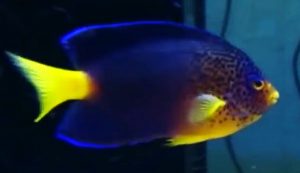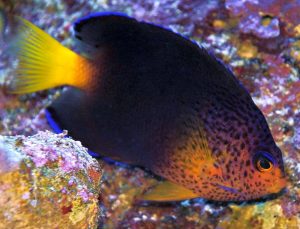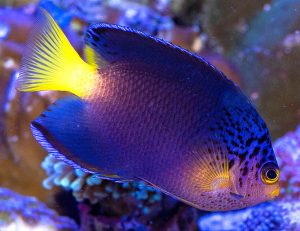The Debelius angelfish (Centropyge debelius) known to tropical fish keeping enthusiasts as Blue Mauritius angelfish are an exceptionally rare pygmy species found only in the Western Indian Ocean; specifically the Mauritius, Reunion Island, and farther north, Aldabra in the Seychelles Islands.
The Debelius angelfish (Centropyge debelius) is an elusive deep water species found darting among the many crevices and cavees along the vertical walls of the outer reef slopes at depths from 165 to 330 feet or more. Recently, a specimen was collected off the Eastern coast of Madagascar in only 49 feet of water; which leads to the possible expansion of their territory to the entire coastline of Eastern Madagascar.
To date, only single specimens have been observed along the deep outer reef slopes occasionally feeding on algae. This may indicate that that the principal breeding populations are located even deeper than 330 feet.
As the name implies, Blue Mauritius Angelfish have a dark purplish blue body color, with a yellow mouth, breast, and a bright yellow tail. Their dorsal and anal fins are a deep purplish blue color edged in bright blue, and they have dark purplish blue to black spots on the face that in some specimens morphs into a vermiculated mask, that is particularly outstanding.
Color has no bearing on sex and it is surmised that males are larger than females.
Like all Centropyge species, juvenile Centropyge debelius start life as unsexed individuals that morph into females as they become adults. The largest or more dominant female within a small group will change sex, and within a few days to a couple of weeks become a male.
The few Debelius angelfish that have been collected are being successfully maintained in FOLR and reef aquariums of at least 70 gallon capacity with plenty of mature live rock arranged into crevices, caves, and overhangs to mimic their deep water reef slope habitat. It has been reported by tropical fish keeping enthusiasts who have kept this species to be just as hardy as any other dwarf angelfish in its genus.
As a deep water species, the lighting in the tank should be dimmed to replicate their deep water habitat and a chiller is recommended to keep the maximum temperature in the tank under 74° Fahrenheit. These reclusive angelfish require very stable water conditions and pristine water quality. Once acclimated, at least monthly 20-30% water changes are recommended.
Debelius angelfish have been bred in an aquarium environment. Compared to other angelfish in the genus Centropyge, Debelius larvae are much more difficult to raise. Of the 14 pygmy Debelius angelfish bred to date, the larval period lasted a minimum of 110 days, which is the longest larval phase for the species cultured to date. The larvae were successfully raised from captive spawned eggs on a diet of wild copepods and artemia for 110 days at a water temperature of 77-79F . Like adult Centropyge debelius, juveniles are very robust but require cooler water temperatures less than 77°F over long periods to thrive.
Like other angelfish in the genus Centropyge, Debellius Angelfish are omnivores that graze mostly on algae, sponges, and detritus. In a reef tank or an aquarium with plenty of aged live rock, they will accept a wide range of angelfish preparations.
In addition to substantial quantities of mature live rock in their tank to graze upon, they should be given a variety of fresh and frozen Mysis shrimp, brine shrimp, Krill
, Cyclops, meaty crustaceans like clams or shrimp, and commercially prepared foods enriched with marine algae
, sponges, and spirulina. Once acclimated, they should be fed at least 2 to 3 times a day.
Because of its rarity, elusiveness, remote location, and the many logistical difficulties of reaching them in its natural habitat, it should come as no surprise that Debelius angelfish (Centropyge debelius) are incredibly rare and not normally seen in the U.S. aquarium trade.
Although most rare deep water species like Centropyge narcosis, Centropyge nahackyi, Centropyge hotumatua, etc. are sold directly to tropical fish keeping enthusiasts in the Asian market where they fetch huge sums of money; Centropyge debelius has still only been rarely available to Japanese collectors, and then only at extremely high prices.
A specimen in 2012 sold for a bargain price of $4,999.00 and was snatched up in seconds. Another specimen was offered for sale in 2018, in Germany, by Dejong Marine Life, for an astounding $18,000.00.
Minimum Tank Size: 70 gallons
Aquarium Type: Deepwater Reef, FOLR
Care Level: Difficult
Temperament: Semi-aggressive
Aquarium Hardiness: Hardy
Water Conditions: 72-79°F, dKH 8 to 12 , pH 8.1 – 8.4, sg 1.023-1.027
Max. Size: 3.5 – 4″
Color Form: Blue, Yellow, Black
Diet: Omnivore
Compatibility: Reef w/Caution
Origin: Mauritius, Aldabra, Reunion, Seychelles Islands, Madagascar
Family: Pomacanthidae
Lifespan: Unknown
Aquarist Experience Level: Professional





I can tell you that now nobody’s is collecting the Centropyge Debelius we often see them on deep dives ( + 70 m ) . There are also a few very small ones ( max 3 cms )
At the price they sell for, you could easily retire by collecting what you encounter.